The very first Kalashnikov rifle that received the AK-47 model designation is displayed in the Military Historical Museum of Artillery, Engineers and Signal Corps which is located in Saint Petersburg, Russia. This rifle has always been somewhat mysterious because its appearance is quite different from the AK-47 that was actually adopted.

If you look at the images of the S/N 1 AK-47, you can clearly see some visual differences such as the long handguard and the mid-bore compensator. This rifle also has a built-in open bolt sear and other design features that we don’t see in the adopted Type 1 AK rifles. It is known that the AK-47 was the final iteration of Kalashnikov’s rifle which successfully passed the final stages of the trials and was adopted by the Soviet military. You should be asking why the very first AK is so different? Did they test this rifle and adopted a completely different one? Did they have enough time to delete all these features during the trials? As you can see, there is quite a bit of mystery surrounding this museum rifle. Thanks to the researchers of the Kalashnikov Gun Magazine, today we’ll find the answers to these questions. Let’s first get into the history then discuss these design differences.
History of the Mystery
In June of 1947, the first stage of the new 7.62x39mm automatic rifle trials was over and three of the contenders made it to the second and final stage. These were the rifles designed by Mikhail Kalashnikov, Alexey Bulkin and Alexander Dementyev. All three designers had to do some minor design improvements to fix the issues seen during the first stage of the trials. For making these minor changes, the designers had about six months because the second stage of the trials was planned to start in December of 1947. Despite this short time, Kalashnikov, with the suggestion of his first assistant Alexander Zaytsev, completely redesigned the rifle to increase its chances of winning the trials.

AK-46 #1

AK-46 #2
This new rifle received a model designation of AK-47. Compared to the AK-46 #1 and #2 that were the rifles tested in the first stage, AK-47 had a totally different layout of the receivers. If the AK-46s had upper and lower receivers, the new rifle was constructed with a single receiver and a separate top cover – the features of the standard AK that we know today. The trigger mechanism was also changed borrowing a lot of features from the Czech ZH-29 rifle. The safety selector lever became also a dust cover for the charging handle slot. All these design changes were basically an attempt to effectively combine every successful existing design solution in a single rifle to make it the best one.
During the final trials, the AK-47 performed flawlessly in terms of the reliability. The failure rate was 0.14% from 15,000 fired rounds. With some very minor last design changes, the AK-47 was adopted by the Soviet military. However, from the very beginning of the trials, it was clear that the rifle was not perfect. Particularly, it had a poor accuracy in burst/full auto fire. This shortcoming was multiple times pointed out by Soviet proving ground officers Vasiliy Lyutiy and Boris Kannel.

Vasiliy Lyutiy (left) and Boris Kannel
Lyutiy and Kannel were not just military officers who tested the firearms and recorded the results. They were professional arms designers with corresponding education and huge experience in designing and testing firearms. Even their military ranks were different and indicated their specialty – engineer-major Lyutiy and engineer-captain Kannel. These gentlemen not only tested and detected the failures but often times they would point out exactly why the failure happened and suggest a design change to solve the issue. Both of them have a huge contribution to the development of AK-47 and other Soviet firearms.

Unmodified AK-47 #1
Being unsatisfied with the accuracy of the AK-47, Lyutiy and Kannel asked to assign them the first AK-47 rifle to experiment with and try to deploy some of their ideas into the design in an attempt of improving it. The actual rifles that took part in the trials were the second and third AK-47s. Kalashnikov Gun Magazine journalists found documents in the archives of the Military Historical Museum of Artillery, Engineers and Signal Corps proving this story. That’s it – the mystery is solved! All the unusual design features seen on the very first AK rifle are the experiments done by Lyutiy and Kannel. Before being modified by these officers, the first AK-47 used to be a “normal” AK. Now let’s take a closer look at these experiments.
Lyutiy-Kannel Experiments
While testing the trial rifles, Lyutiy and Kannel found out that the furniture of the rifle had a poor design and didn’t allow to control the weapon properly which they considered one of the reasons of poor accuracy in full auto mode. Particularly, the officers pointed out that the stock was too short, the pistol grip angle was excessive and the smooth and short handguard was also a design flaw. They made a new stock which was 25mm (about an inch) longer and featured a different height of the butt portion as well as serrations on the buttplate. Lyutiy and Kannel also designed a new pistol grip with a grip angle decreased from 123° to 105°. And finally, they changed the design of the handguard making it beefier, longer (retained at the gas block) and scalloped to provide a better purchase.

Lyutiy-Kannel handguard
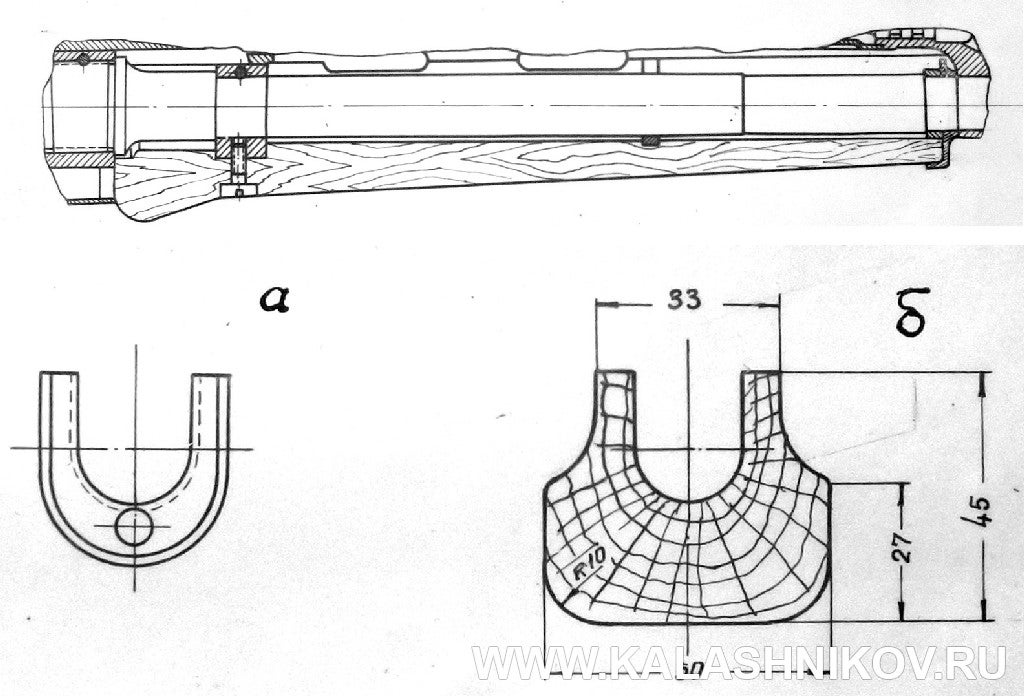
Lyutiy-Kannel handguard drawing
Another part that Lyutiy and Kannel redesigned was the barrel. They replaced the original barrel with a thicker profile one. Although the new barrel was 70 grams (about 2.5 oz) heavier, they were expecting that it will increase the accuracy and the service life of the barrel. They also considered the muzzle device of the test rifles ineffective and deleted it.
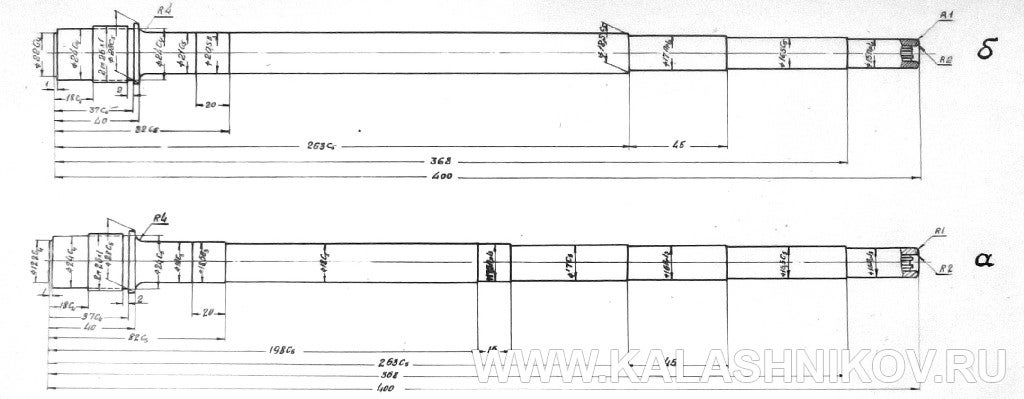
Lyutiy-Kannel barrel (on top) compared to the original AK-47 barrel
All these design changes proved to increase the burst fire accuracy by up to 31.4% depending on the stance. This was quite a good achievement but they were sure that they can further improve the design. Lyutiy and Kannel understood that in order to reach more significant results, they had to incorporate more in-depth changes into the design.
At this point, they decide to design a sort of a mid-bore brake for the rifle which they called “stabilizer”. The stabilizer was mounted onto the barrel, right behind the front sight block. It consisted of 6 ports (three on each side) and the barrel had corresponding holes drilled into it. They had an early experience with effective muzzle brakes tested on Sudayev’s AS-44 rifle which made the 7.62x39mm rifle as controllable as the PPSh chambered in 7.62x25mm. The stabilizer proved to be extremely effective too making the rifle easier to shoot and almost twice improving the accuracy. The downside of this device was that being mounted not on the muzzle but on the barrel, it vented significant amount of gasses thus decreasing the muzzle velocity from 715 m/s (2,346 fps) to 650 m/s (2,132 fps).
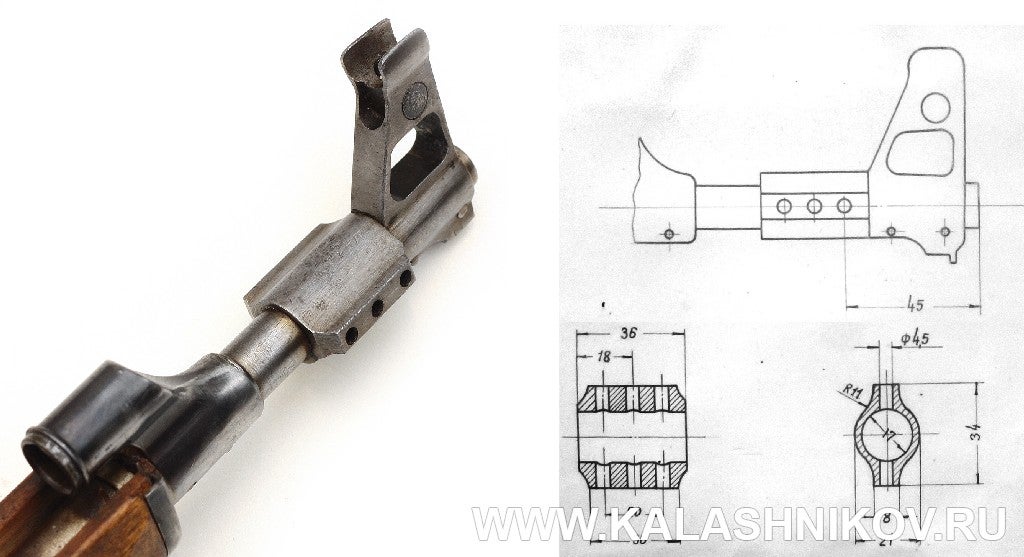
The “stabilizer” device
At this stage of improvement works, Lyutiy and Kannel found out that when fired on full auto mode, the AK-47 had a tendency of printing two groups. The first several bullets landed at the point of aim, then the following shots formed a second group slightly higher than the first one. Making the gun more controllable, didn’t really solve this issue. By examining the work of the action, they came to the conclusion that this was caused by the bolt carrier group violently slamming into the rifle when closing the action. At first, they tried to change the point of impact of the BCG but then decided to once again use the knowledge gained during the trials. They designed a drop in trigger mechanism part that allowed to shoot the rifle from an open bolt. Earlier, they observed that Sudayev’s AS-44 rifle, which was an open bolt gun, was more accurate in full auto mode and didn’t have that “double grouping” issue.
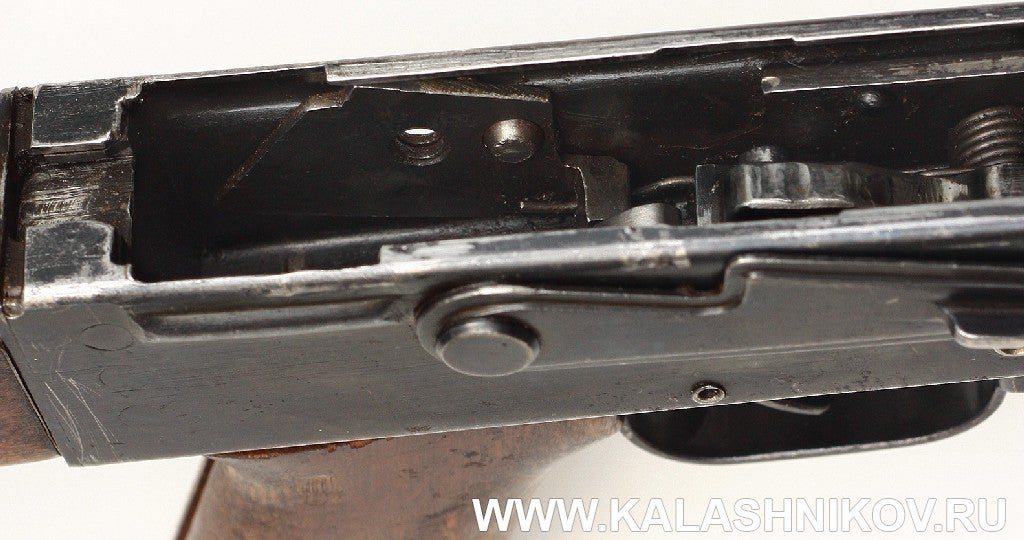
The open bolt sear is located on the left wall of the receiver
So the rifle was still a hammer-fired one but after the conversion, it fired from an open bolt. They also tried to time the open bolt sear so that the hammer would hit the firing pin in the small time gap when the bolt carrier has already closed the action but still needs to travel the distance of the underslide before it hits the front trunnion and comes to rest. That way, the bolt carrier itself would have no front impact point. To decrease the speed of the BCG after it has closed the action and make this system work properly, they even designed a special bolt carrier brake. The latter consisted of a pair of gas tube mounted spring-loaded plungers which would apply pressure against the conical base portion of the gas piston thus slowing down the forward motion of the bolt carrier at the last millimeters of its travel distance. This bolt carrier brake was a poor solution – it totally changed the harmonics and caused malfunctions every 3-4 rounds. They removed this mechanism from the rifle that’s why we don’t see it on the museum sample. Overall, the experiment with open bolt firing seemed to have an advantage, but this mechanism had to be thoroughly redesigned. Also, on single shot mode, the open bolt is not an advantage at all.

AK-47 with the gas tube mounted bolt carrier brake mechanism
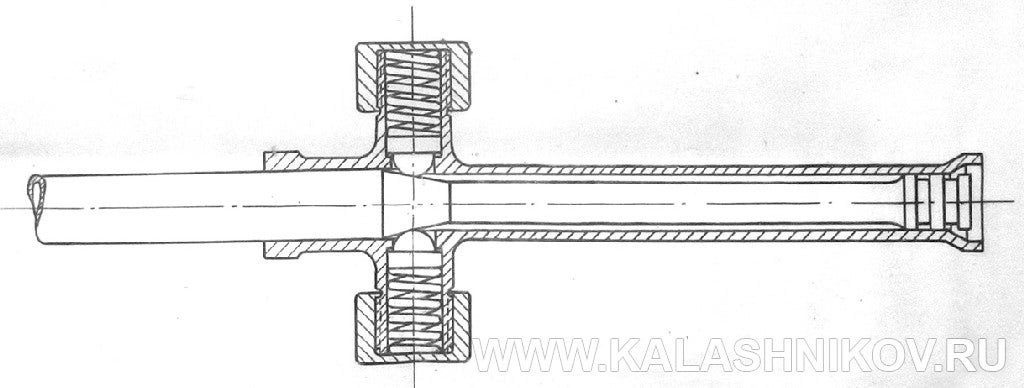
Drawing of the bolt carrier brake mechanism

The arrow shows the tapered base of the piston where the spring loaded bolt carrier brake plungers applied the pressure
Although being really interesting, none of these experimental devices were incorporated into the AK-47 design and it was adopted as the AK-47 Type 1. Nevertheless, Lyutiy-Kannel study provided some valuable data and knowledge. For example, the disadvantage of the excessive grip angle was acknowledged and fixed – starting from 1951 we see a less angled grip on the AK-47 Type2. Later, in 1959, they also improved the design of the handguard on the AKM.
I hope you enjoyed this article and learned something new about the history of Mikhail Kalashnikov’s iconic Avtomat. Stay tuned to read more articles like this!
Sources:
Chumak R. (2018, November 11). “Заново рождённый. Удивительная история АК-47 № 1”. Kalashnikov Gun Magazine. Retrieved from: https://www.kalashnikov.ru/zanovo-rozhdyonnyj-udivitelnaya-istoriya-ak-47-1/
 Your Privacy Choices
Your Privacy Choices
